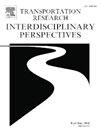评估发展中城市集体固定路线辅助交通服务的可及性:吉布提案例研究
IF 3.9
Q2 TRANSPORTATION
Transportation Research Interdisciplinary Perspectives
Pub Date : 2024-11-01
DOI:10.1016/j.trip.2024.101270
引用次数: 0
摘要
本研究通过地理信息系统和住户调查等多种数据来源,对吉布提集体固定路线辅助交通服务的可达性进行了全面评估,并对当前状况进行了研究。建议的可达性模型考虑了步行时间、等待时间和覆盖率。该模型将基于步行时间的可达性下降与辅助公交乘客减少联系起来。为了评估等候时间的影响,该模型将可接受的等候时间(5 分钟)与服务的平均等候时间进行了比较。8 分钟的步行时间阈值定义了服务覆盖范围。结果表明,固定路线集体服务仅覆盖了该市市区面积的 39.49%。虽然市中心的可达性较高,但郊区面临着巨大的可达性差距。这项分析不仅揭示了市内无障碍环境的空间分布,还突出了急需改善的区域。研究还包括辅助交通无障碍地图,该地图用颜色标示了整个城市的无障碍程度。这些研究结果有助于促进对辅助公交可达性的研究,强调了空间和时间因素的整合,以加强城市交通规划。这项研究的洞察力可为循证决策提供支持,并促进该地区的可持续城市发展。本文章由计算机程序翻译,如有差异,请以英文原文为准。
Evaluating the accessibility of collective fixed-route paratransit service in developing cities: A case study of Djibouti
This study provides a comprehensive evaluation of accessibility for collective fixed-route paratransit services in Djibouti, examining current conditions through diverse data sources, including geographic information systems and household surveys. The proposed accessibility model considers walking time, waiting time, and coverage ratio. It correlates the decrease in accessibility based on walking time with the reduction in paratransit ridership. To assess the impact of waiting time, the model compares an acceptable waiting time (5 min) with the average waiting time of the service. A threshold walking time of 8 min defines the service coverage area. Results indicate that the collective fixed-route service covers only 39.49% of the city’s urban area. Although accessibility is higher in the city center, the outskirts face substantial accessibility gaps. This analysis not only reveals the spatial distribution of accessibility within the city but also highlights areas with urgent improvement needs. The study includes paratransit accessibility maps with color-coded levels of accessibility across the city. These findings contribute to the growing research on paratransit accessibility, emphasizing the integration of spatial and temporal factors for enhanced urban mobility planning. The insights from this research can support evidence-based policy-making and promote sustainable urban development in the region.
求助全文
通过发布文献求助,成功后即可免费获取论文全文。
去求助
来源期刊

Transportation Research Interdisciplinary Perspectives
Engineering-Automotive Engineering
CiteScore
12.90
自引率
0.00%
发文量
185
审稿时长
22 weeks
 求助内容:
求助内容: 应助结果提醒方式:
应助结果提醒方式:


